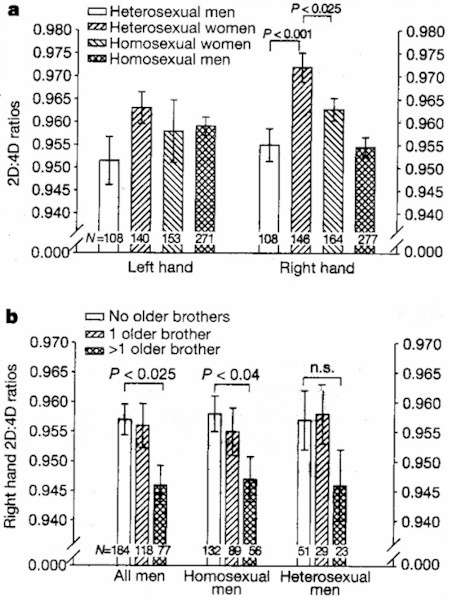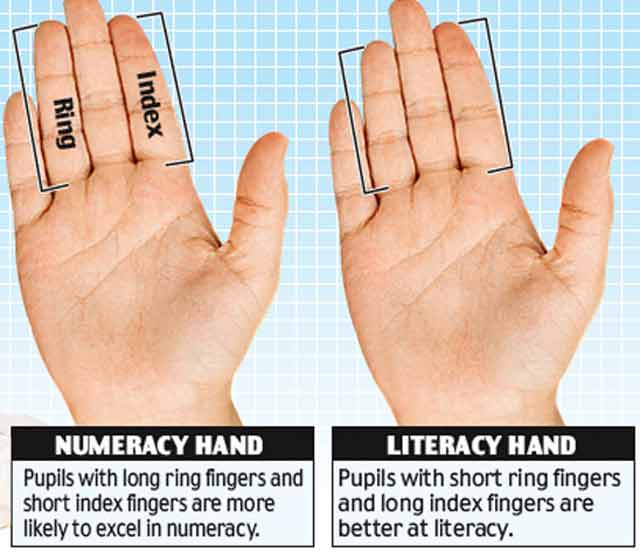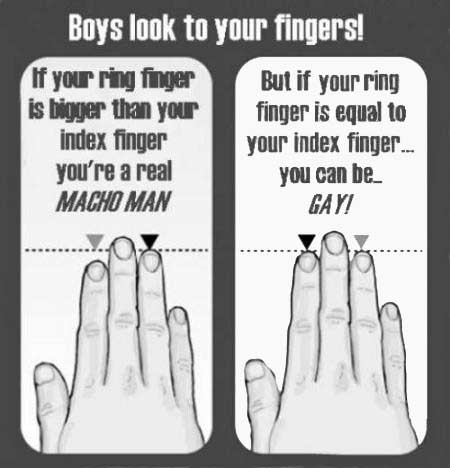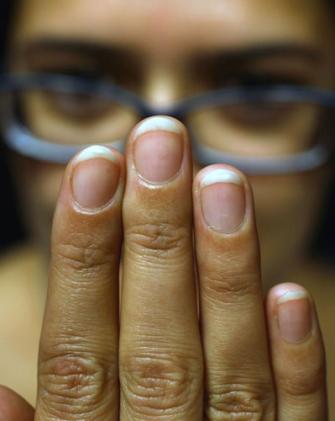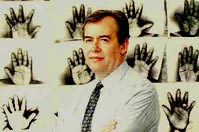Finger It Out
Finger-length Ratios and Sexual OrientationMy hope is that gays will be running the world, because then there would be no war. - Roseanne Barr If male homosexuals are called "gay," then female homosexuals should be called "ecstatic." - Shelly Roberts You will one day be so proud of all your children, don't impede their progress now - Rosaleen Dickson Measuring people's finger patterns may reveal some surprising information. Animal models have indicated that androgenic steroids acting before birth might influence the sexual orientation of adult humans. Here we examine the androgen-sensitive pattern of finger lengths [1], and find evidence that homosexual women are exposed to more prenatal androgen than heterosexual women are; also, men with more than one older brother, who are more likely than first-born males to be homosexual in adulthood[2], are exposed to more prenatal androgen than eldest sons. Prenatal androgens may therefore influence adult human sexual orientation in both sexes, and a mother's body appears to "remember" previously carried sons, altering the fœtal development of subsequent sons and increasing the likelihood of homosexuality in adulthood. In women, the index finger (2D, second digit) is almost the same length as the ring finger, the fourth digit (4D), although it may be slightly longer or shorter; in men, the index finger is more often shorter than the fourth. The greater 2D:4D ratio in females is established in two-year-olds[1]. Because all non-gonadal somatic sex differences in humans appear to be the result of fœtal androgens that masculinise males[3], the sex difference in the 2D:4D ratio probably reflects the prenatal influence of androgen on males[4]. In an anonymous survey, 720 adults who were attending public street fairs in the San Francisco area were asked their gender, age, sexual orientation, handedness, and the number and gender of children their mother had carried before them. As expected, men have significantly longer fingers than women (P < 0.001), and we confirmed reports that the 2D:4D ratio is greater in women than it is in men. This sex difference in 2D:4D is greater on the right hand than on the left (see figure 1a below), indicating that the right-hand 2D:4D is more sensitive to fœtal androgens than the left-hand ratio. The right-hand 2D:4D ratio of homosexual women was significantly more masculine (that is, smaller) than that of heterosexual women, and did not differ significantly from that of heterosexual men. Thus finger ratios, like otoacoustic emissions[5], suggest that at least some homosexual women were exposed to greater levels of fœtal androgen than heterosexual women. The 2D:4D ratio of homosexual men was not significantly different from that of heterosexual men for either hand (P > 0.09). However, segregating male subjects based on birth order provided support for the role of fœtal androgens in male sexual orientation. The more older brothers a boy has, the more likely he is to develop a homosexual orientation[2]. Confirming these reports, we also found that only homosexual men had a greater than expected proportion of brothers (P < 0.01) among their older siblings (229 brothers: 163 sisters) compared with the general population (106 males: 100 females [6]. We found that the male 2D:4D ratio, which is unlikely to be influenced by social factors, also varies with the number of older brothers. The ratio was significantly more masculine in men with two or more older brothers than in men with no older brothers (Figure 1b). There is also a significant correlation (r = -0.104; p < 0.05) between the number of older brothers and the right-hand 2D:4D ratio in men. If male subjects are divided by sexual orientation, the same pattern of later-born men displaying a more masculine 2D:4D is seen. Having older sisters has no apparent influence on male sexual orientation[2], or on the 2D:4D ratio in men. No effect of older brothers or sisters on 2D:4D in women was observed, consonant with reports that older siblings exert no effect on female sexual orientation[7]. Our results suggest that events before birth (or even before conception in the case of older brothers) influence human sexual orientation. The masculinised right-hand 2D:4D ratio in homosexual women may reflect fœtal androgen levels that are slightly higher than in heterosexual women. Homosexual men without older brothers have 2D:4D ratios indistinguishable from heterosexual eldest sons, indicating that factors other than fœtal androgen (such as genetic influences[8,][9] also contribute to sexual orientation. Finger measures indicate that men with more elder brothers, including those men who develop a homosexual orientation, might be exposed to greater than normal levels of prenatal androgen. Although hyper-androgenisation of homosexual men might not fit some cultural expectations[10], homosexual men display several hyper-masculine characteristics, including a greater mean number of sexual partners in a lifetime than heterosexual men, who in turn report more sexual partners than do women of either orientation. Furthermore, reports that adult homosexual men have more circulating androgens (refer to [11], but see ref. [12]), larger genitalia[13], and more "masculine" auditory evoked potentials than heterosexual men[14], are consistent with at least some homosexual men being hyper-androgenised. Although it is possible that the maternal influence on finger growth of subsequent sons occurs after birth, a prenatal influence seems more likely because of the extensive physiological pairing of mother and fœtus. The locus of the maternal "memory" for previous sons, and the mechanisms by which fœtal development of subsequent sons is altered, remain unknown. Terrance J WIlliams, Michelle E Pepitone, Scott F Christensen, Bradley M Cooke, Andrew D Hubennan, Nicholas J Breedlove, Tessa J Breedlove, Cynthia L Jordan, S Marc Breedlove Department of Psychology and Graduate Groups Neuroscience, Endocrinology, 3210 Tolman Hall, MC 1650, University of California, Berkeley, California 94720-1630 USA email: breedsm@socrates.berkeley.edu
Figure 1: Finger-length patterns vary with gender, sexual orientation and birth order. a, Among heterosexuals, the mean 2D.4D ratio is larger in women than in men, especially on the right hand. The right-hand 2D:4D ratio of homosexual women is more masculine (that Is, smaller) than that of heterosexual women. b, Men with more than one older brother are more likely to be homosexual and have a significantly more masculine right-hand 2D:4D ratio than men without older brothers. Subjects were offered lottery "scratcher" tickets for their participation. Age and handedness were not significantly different between heterosexual and homosexual subjects; we found no relation between handedness or age and finger measures. Finger lengths were measured blindly from photocopies of subjects' hands. Repeated measurements from 381 subjects were highly correlated (r was +0.95 to +0.99). Standard errors of the means are depicted. All P values, from Student's t-tests, are two-tailed. (n.s. means Not significant)
[1.] Manning J T, Scott D, Wilson J and Lewis-Jones D I Human Reproduction 13: 3000 - 3004 (1998). [2.] Blanchard R Annual Review Sex Research 8: 27 - 67 (1997). [3.] Breedlove S M, Cooke B M and Jordan C L Brain Behaviour Evolution 54: 8 - 14 (1999). [4.] Manning J T, Trivers R L, Singh D and Thornhill R Nature 399: 214 - 215 (1999). [5.] McFadden D and Pasanen E Procedings of the National Academy of Sciences USA 95: 2709 - 2713 (1998). [6.] James W H Human Biology 59: 721 - 752 (1987). [7.] Bogaert A F Behavioural Neuroscience 111: 1395 - 1397 (1993). [8.] Bailey J M and Pillard R C Archives of General Psychiatry 48: 1089 - 1096 (1991). [9.] Hamer D D, Hu S, Magnuson V L, Hu N, and Pattatucci A M L Science 261: 321 - 327 (1993). [10.] Gorman M R Perspectives in Biological Medicine 38: 61-81 (1984). [11.] Brodie H K H et al American Journal of Psychiatry 131: 82 - 83 (1974). [12.] Mayer-Bahlburg H F L Progress in Brain Research 61: 375 - 398 (1984). [13.] Bogaert A F and Hershberger S Archives of Sexual Behaviour 28: 213 - 221 (1999). [14.] McFadden D and Champlin C A Journal of Associated Research in Otolaryngology (in the press). Source: Nature Vol 404 30 March 2000
Is This the New Phrenology?
Length of Fingers "Show How a Pupil Will Do at Maths or English"by Laura Clark Parents can predict their children's exam performance simply by looking at their hands, according to research. Psychologists claim that results in English and maths tests are linked to the length of fingers. Pupils with longer ring fingers are said to be more likely to excel in numeracy while those with shorter ring fingers tend to be more adept at literacy. Scientists believe the trends can be explained by the levels of testosterone and œstrogen that children are exposed to in the womb. The sex hormones are thought to govern brain development as well as finger length. Mark Brosnan, who led the study at the University of Bath, said: "Testosterone has been argued to promote development of the areas of the brain which are often associated with spatial and mathematical skills. Œstrogen is thought to do the same in the areas of the brain which are often associated with verbal ability. Interestingly, these hormones are also thought to have a say in the relative lengths of our index and ring fingers. We can use measurements of these fingers as a way of gauging the relative exposure to these two hormones in the womb. And, as we have shown through this study, we can also use them to predict ability in the key areas of numeracy and literacy." In the research project, which has been published in the British Journal of Psychology, scientists measured the finger lengths of 75 seven-year-olds by using photocopies of their palms. For each child, they took measurements of the index and ring fingers on their right hands. They divided the length of the index finger by the length of the ring finger to calculate each child's "digit ratio." Adult women usually have ratios of one - with index and ring fingers of equal length. The average for men is lower, at 0.98, since they tend to have longer ring fingers than index fingers, suggesting greater exposure to testosterone in the womb. Using scores in "key stage" English and maths tests, the researchers compared the measurements of the study group - who all attended an infants' school in Bath - with their performance in the classroom. They found that children with smaller digit ratios - a longer ring finger and greater pre-natal exposure to testosterone - were more likely to be better at maths than English. Similarly, pupils with higher ratios - shorter ring fingers and greater exposure to œstrogen - performed better in English tests than maths. Longer ring fingers in boys were also strongly linked with higher scores in numeracy tests. Source: dailymail.co.uk 23 May 2007
Finger Length Predicts SAT PerformanceA quick look at the lengths of children's index and ring fingers can be used to predict how well students will perform on SATs, new research claims. Kids with longer ring fingers compared to index fingers are likely to have higher math scores than literacy or verbal scores on the college entrance exam, while children with the reverse finger-length ratio are likely to have higher reading and writing, or verbal, scores versus math scores... In the future, Brosnan's team will see if finger-length ratios are related to other cognitive and behavioural issues, such as technophobia, career paths and possibly dyslexia. Source: news.yahoo.com 23 May 2007
Success Isn't Written in the Stars, It's in the Length of Your Fingers
The traditional pattern in women, long index fingers can predict a child's academic strengths by Jeremy Laurance It is the simplest hands-on experiment – and, for once, it is safe to try this at home. Compare the length of your fingers and predict your own future. Everything from sporting prowess to academic ability, sexual orientation to susceptibility to disease can be assessed on the twin measurements of the length of the ring and index fingers. It is science's answer to palmistry. Researchers at Cambridge University have found that finger length can point to success in the City. Traders with longer ring fingers made the most money – up to 6 times more than those whose ring fingers were relatively short. The study, published in Proceedings of the National Academy of Sciences, found finger size accounted for 20% of the difference. Though the finding provoked scepticism – one blogger tartly responded, "Scientists with little else to do than measure fingers should pull their own out" – the Cambridge boffins are not alone. The significance of finger length has been investigated by research groups worldwide – with surprising results. The ratio between index and ring finger is believed to be linked to exposure to the male hormone testosterone in the womb. On average, men tend to have longer ring fingers and women longer index fingers. The higher the testosterone, the greater the length of the ring finger and the more "masculine" the resulting child – whether male or female. The longest ring finger is known as the "Casanova pattern". Professor John Manning, author of The Finger Book, said the ratio was a "living fossil" of the early period of pregnancy – a measure of past exposure to testosterone, and future potential. More often found in men than women, people with longer ring fingers tend to excel on the sports field, especially in running and football. Scientists at the University of Bath found that children who had longer ring fingers are better with numbers-based subjects such as maths and physics, which are traditionally male favourites. A study this week showed autism may be linked with exposure to testosterone in the womb. Autism is sometimes described as the "extreme male brain" and is 4 times more common in boys than girls. Finger length might provide an early warning of the condition. Canadian researchers from the University of Alberta have found a correlation between length of the ring finger and levels of physical aggression – as would be expected in the most masculinised individuals. The traditional pattern in women, long index fingers can predict a child's academic strengths. Scientists at the University of Bath found that longer index fingers indicated good verbal and literacy skills, where girls dominate. The findings were published in the British Journal of Psychology in 2007. Studies of sexual orientation have shown that lesbian women are more likely to have longer ring fingers, suggesting exposure to higher levels of foetal testosterone. Professor John Manning said research he had conducted suggested that gay men were more likely to display feminised finger ratios, suggesting less testosterone exposure in the womb. However, sceptics have observed that twin studies show that 70% of the difference in finger length is inherited from our parents. Jeremy Laurance is Health Editor for The Independent Source: independent.co.uk 14 January 2009 photo credit Susannah Ireland
Pointing the FingerA child's future really may be written in his hands - not in the creases of his palms but in the relative lengths of his fingers. A report just published in Developmental Medicine and Child Neurology suggests that people with autism have ring fingers that are abnormally long compared with their index fingers. Children with autism have trouble interacting with other people. Both their verbal and their gesture-based communication is poor, and they often have low intelligence. Early hallmarks - a failure to point at things, follow the gaze of someone else, or engage in pretend play - are often obvious by the tender age of 18 months. About one child in 500 suffers from the condition. John Manning, a researcher at the University of Liverpool, in Britain, who has studied what fingers can indicate about everything from fertility to sexual preference, teamed up with Simon Baron-Cohen at the University of Cambridge, whose expertise is in autism. They studied 72 autistic children and 23 with Asperger's syndrome, a related condition in which the individual's intelligence is not affected. Dr Manning and Dr Baron-Cohen photocopied the children's hands, and carefully measured the lengths of their subjects' fingers from the copies. They worked out the ratio of the length of the index finger to the length of the ring finger for each child, and compared it with those of 34 of the children's healthy siblings, 88 of their fathers, 88 of their mothers, and a number of unrelated controls that were matched for sex and age. The relative sizes of someone's fingers are fixed for life within three months of conception, and the relationship seems to be governed by testosterone. Although the reason is not yet understood, earlier studies have shown that finger-length ratios are a robust marker of how much of that hormone a baby has been exposed to in utero - the more testosterone, the longer the ring finger. Overall, therefore, men tend to have longer ring fingers than index fingers, whereas in women the two fingers are more likely to be of equal length. Dr Manning and Dr Baron-Cohen found that autistic children had extremely long ring fingers compared with their index fingers. Children with Asperger's also had abnormal index-to-ring finger ratios, though less so than full-blown autistics. Even the unaffected siblings and parents of the autistic children had ratios that differed significantly from the normal controls. That may sound surprising, but high levels of testosterone in the womb have been linked to several other brain-related phenomena, including left-handedness, dyslexia and female homosexuality. Dr Manning thinks that the families of autistic children are genetically predisposed to produce high levels of testosterone during early development. (The fœtus makes most of the testosterone itself. In males, it comes from the testes and adrenal glands; in females from the adrenals alone. Only a small amount, if any, comes from the mother.) While high levels of testosterone may not solve the whole puzzle of autism, Dr Manning thinks levels in utero may be an important piece of it. The finding bolsters what is known as the "extreme male brain" theory of autism. As the name suggests, autism - which is, in any case, much more common in men than women - may simply be an extreme magnification of traits, such as problems with communication and empathy, that psychological testing has shown (to the surprise of few women) are more frequently found in men. Source: The Economist 24 March 2001 See also:
High levels of testosterone cause problems with communication and empathy, huh? I somewhere that lawyers tend to have higher than normal levels of testosterone. Maybe this helps to explain some of their most noteworthy characteristics...
Hidden Significance of a Man's Ring FingerScientists at The University of Liverpool have found a link between finger length and depression in men: the longer a man's fingers are relative to his height, the more likely he is to suffer from depression. Ironically, perhaps, the strongest single indicator is the relative length of his ring finger. The key to this improbable link appears to be testosterone. Some kind of link has been suspected for some time: the loss of libido which accompanies many episodes of depression has led scientists to hypothesize that testosterone levels diminish during depression, and rise again upon recovery - but in fact, research results have been equivocal. The University of Liverpool study confirms suspicions regarding testosterone and depression, but suggests that the culprit is prenatal testosterone, produced from week 8 of a pregnancy, rather than day-by-day testosterone levels in adults.
Dr Manning displaying a series of photocopied hands Dr John Manning of the University's School of Biological Sciences explains: "Fœtal testosterone plays a key role in the development of the male genital system. It also impacts on the development of fingers and thumbs, and the central nervous system. Men who experienced high concentrations of fœtal testosterone have relatively long fingers - in particular, fourth digits which are longer than their second digits. Conversely, men who experienced low concentrations of fœtal testosterone have shorter fourth digits than their second digits." Dr Manning, his colleague Sue Martin and Professor Chris Dowrick of the University's Department of Primary Care studied 102 men and women from different socioeconomic backgrounds. Each had a variety of physical measurements taken, including wrist size, ear size, height - and the length of digits 2 to 5 (that is, their fingers) from the basal crease to the tip. The Beck Depression Inventory (BDI) - widely used to detect depression in the population as a whole, as well as psychiatric patients - was then deployed to identify those who suffered from depression, and to score the severity of their depression. The results showed that in men - but not women - a high BDI score was positively related to long digits, particularly the fourth digit (the ring finger). Dividing digit length by height, to take account of the fact that taller men tend to have longer limbs, fingers and feet, gave an even stronger predictor of high BDI scores in men. Fœtal testosterone concentrations are the most likely explanation, given the sex-dependent pattern of the data. Says John Manning, "Testosterone has strong influences on the development of the male nervous system - not all of them beneficial. It is believed that excess testosterone promotes the growth of the right hemisphere of the brain at the expense of the left hemisphere. This can lead to impaired reading ability, but also to enhanced mathematical and musical abilities. Unfortunately, there seem to be other, less welcome effects: excess testosterone has already been implicated in the origins of migraine, autism, stuttering, schizophrenia - and now depression, too. "Interestingly, the study's results suggest that depression in women has a different and as yet undetermined origin." Having relatively long ring fingers does not necessarily mean that a man will, in fact, suffer from depression - just as people with high cholesterol levels do not necessarily have a heart attack. However, since the symptoms of depression can discourage sufferers from acknowledging their condition and seeking treatment, ring finger length could offer GPs a simple, objective indicator of susceptibility in men. This is not the first time that John Manning's research has identified a hidden significance of finger length. Last year he established a link between the relative length of women's ring fingers and their fertility levels: women with shorter ring fingers than forefingers tend to have high fertility. Conversely, men with relatively long ring fingers are more likely to have high fertility. His work has now attracted the interest of the Wellcome Trust, which recently awarded him an innovative research grant to support an investigation into a possible association between risk of heart attack and second to fourth digit ratio. The results of this study were published by Martin SM, Manning JT & Dowrick CF in "Fluctuating Asymmetry, Relative Digit Length and Depression in Men", Evolution and Human Behaviour 20: 203-214 (1999) For further information contact John Manning: jtmann@liverpool.ac.uk Source: liv.ac.uk September 1999
Finger Length Heart Attack ClueA long ring finger may be good news. The length of a young boy's finger may provide a clue as to whether he will be at risk of a heart attack in early adulthood. Scientists at Liverpool University have established a link between the length of baby boys' fingers and their chances of going on to have a heart attack at an unusually young age. They believe the link could provide doctors with a simple way to to spot potential heart disease victims at a very early age. The research shows that boys with shorter ring fingers tend to be at greatest risk. This is because these boys tend to have lower levels of the male sex hormone testosterone, which is known to protect against heart attack. The genes that are indirectly responsible for the production of testosterone and the female hormone œstrogen also control the development of the fingers. Finger measurement: divide the length of your index finger by the length of your ring finger to give the ratio. For the average male in Britain, this figure is about 0.97. Below 0.9 an individual is unlikely to have a heart attack early in life. Above 1.00 the risk climbs. Lead researcher Dr John Manning told the BBC, "Males tend to have a relatively longer ring finger compared to the index finger than females. This is a very early trait and it is under the influence of sex hormones. For a man, the ring finger tends to be about 2% longer than the index finger. The longer your ring finger, the more protected you are against heart attack, because the more testosterone you have. There is a relationship between the ratio between these two finger lengths and the age at heart attack of people who do have heart attacks." The ratio between the two fingers remains the same throughout life. Short ring fingers did not necessarily mean that boys would go on to have heart attacks, but should alert their parents to do what they can to lessen the risk. Dr Manning said, "This is an indicator of risk independent of things like smoking and diet, so you can adjust your diet and stop smoking and so on, if you are in a high-risk group." Dr Manning and Dr Peter Bundred examined 151 male heart attack victims in Merseyside. They found the age range for heart attacks in men where the index finger was relatively long was 35 to 80 years of age, but in those with relatively long ring fingers it was 58 to 80. Dr Manning has previously uncovered links between finger-length and vulnerability to depression and sporting ability. The research is to be published in the British Journal of Cardiology Source: news.bbc.co.uk Monday 22 October 2001
Women with Ovary Disease Have Male Finger PatternWomen with polycystic ovary syndrome (PCOS), a common hormonal disorder that can cause irregular menstrual periods among other things, have finger length patterns similar to that of men, according to a new study from Australia. Finger length patterns differ between men and women. In men, the 2nd finger is shorter than the 4th finger, while in women this difference is not evident, note Fleur R Cattrall from Monash University in Melbourne, Victoria, and her colleagues. The disparity might be explained by differences in the hormones that men and women are exposed to before birth, the researchers explain in their paper in the December issue of Fertility and Sterility. This idea is supported by the fact that women with conditions characterised by elevated levels of the male hormone testosterone during fœtal development often have a masculine finger length pattern. To determine whether women with PCOS have masculine finger length patterns, Cattrall's group conducted a comparison study involving 70 women with PCOS and 70 women without the condition, between the ages of 18 and 40. The investigators measured the 2nd to 4th finger length ratio on the palms of the left and right hand. Compared with the other women, PCOS patients had finger length patterns on the right hand that more closely resembled those of men. The team suggests that the masculinised finger length pattern they identified could be considered evidence of testosterone exposure in fœtuses destined to develop PCOS. Source: news.yahoo.com 11 January 2006 via Fertility and Sterility, December 2005
For more on the unusual: events, abilities, means of self-expression, houses, conditions, people, luck, narrow escapes, resemblances, facts, diversions, heroism and more - click the "Up" button below to
take you to the Index page for this Odds and Oddities section. |
 Animals
Animals Animation
Animation Art of Playing Cards
Art of Playing Cards Drugs
Drugs Education
Education Environment
Environment Flying
Flying History
History Humour
Humour Immigration
Immigration Info/Tech
Info/Tech Intellectual/Entertaining
Intellectual/Entertaining Lifestyles
Lifestyles Men
Men Money/Politics/Law
Money/Politics/Law New Jersey
New Jersey Odds and Oddities
Odds and Oddities Older & Under
Older & Under Photography
Photography Prisons
Prisons Relationships
Relationships Science
Science Social/Cultural
Social/Cultural Terrorism
Terrorism Wellington
Wellington Working
Working Zero Return Investment
Zero Return Investment